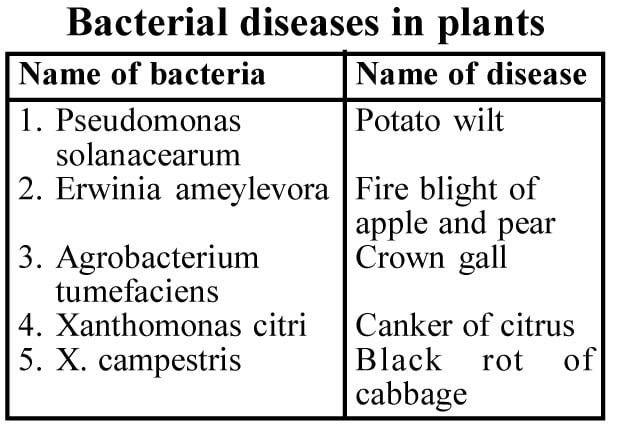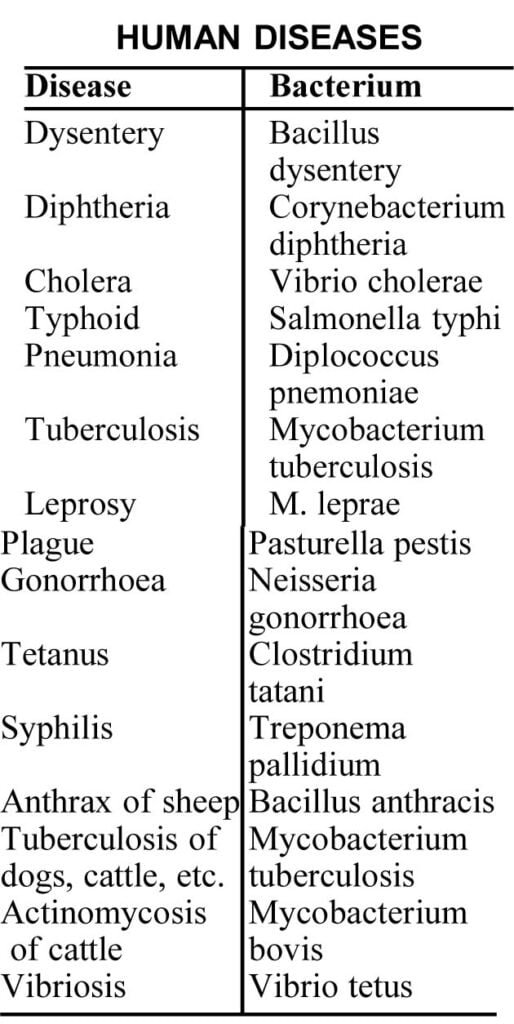Bacteria : Bacteria are unicellular, minute, microscopic organisms. Bacteria were first observed by Anton van Leeuwanhoek in 1675.
Occurence : Bacteria are found in soil, atmosphere or inside the living organisms. They are also found in deep sea water, water springs, and ice.
Size : Majority of bacteria are in the range of 0.5 to 50 microns. Smallest one is pasturella 0.2 to 0.7 micron in size.
Bacteria are of four types—
(a) Coccus—Spherical shaped.
(b) Bacillus—Rod shaped.
(c) Spirillum—Cork screw shaped.
(d) Vibro—Comma shaped.
Description of these four types is given below—
(a) Cocci (Sing. coccus) : These are oval or spherical shape of bacteria.
Monoccoccus : A single spherical bacterium.
Diplococcus : A pair of spherical bacteria.
Streptococus : A chain of spherical bacteria.
Staphylococcus : A cluster of spherical bacteria.
Sarcina : Eight spherical bacterial cells arranged in the form of a cubical colony.
(b) Bacilli (Sing. Bacillus) These are Rod shaped bacteria.
Monobacillus : A single rod shaped bacterium.
Diplobacillus : A pair of rod shaped bacterium.
Streptobacillus : A chain of rod shaped bacterium.
Palaside : A cluster of rod shaped bacteria arranged in the form of grana.
(c) Spirilla (sing. spirillum) : These are helical or spiral shaped bacteria.
(d) Vibrios : These comma shaped bacteria are called Vibrois and derive the name from their characteristic vibratory motility. They occur individually.
Pleomorphic Bacteria : They change their shape in response to environmental conditions and nutrient availability. Such bacteria are called Pleomorphic bacterria, e.g. Acetobacter.
Gram Staining : In Gram staining, the bacterial smear is first treated with crystal violet. All bacteria turn deep blue in colour. They are next treated with Gram’s iodine solution and then decolourised with ethyl alcohol. Later, they are counter-stained with safranine. Some bacteria retain the purple violet colour, called as Gram positive bacteria. The other bacteria which give out the purple violet colour and retain red colour are known as Gram negative bacteria.
Slimy Layer (Capsule) : Some bacterial cells, especially Gram negative bacteria, are externally surrounded by slimy or mucilaginous layer called slime layer or capsule. It is also called ‘Glycocalyx layer’.
Cell Wall : The bacterial cell wall is rigid, hence these are considered as plants.
Plasma Membrane : It is a thin layer bounding the protoplasm of the cell.
Mesosomes : In Gram positive bacteria, the plasma membrane invaginates and develops infoldings, called mesosomes.
Cytoplasm : Cell organelles like plastids, mitochondria, endoplasmic reticulum and golgi complex are absent in bacterial cell.
Ribosomes : The ribosomes of bacterial cell are 70s type with 50s and 30s subunits.
Gas Vacuoles : Gas vacuoles are present in cyanobacteria.
Nuclear Material : True nucleus is absent in bacteria. The nuclear material is also known as nucleoid. It is not bounded by nuclear membrane in bacterial cell.
Plasmids : In bacteria, extra-chromosomal segments of DNA are found in cytoplasm. These strucutures are called Plasmids and episomes.
Flagella : Flagella are present in motile bacteria. Flagellum is about 0.01 to 0.02 nm diameter and 15-20 nm length. Structurally flagellum consists of three parts, known as filament, hook and basal body (blephroplast).
Pili (Fimbriae) : Pili are thin, rigid, hair like, non-flagellar surface appendages.
Autotrophic Bacteria : Autotrophic bacteria can synthesize their own food materials.
Photoautotrophic (phyto-synthetic) bacteria : The light energy (sunlight) is main source of energy for photoautotrophic bacteria. Carbon dioxide is chief source of carbon in these bacteria. They can carry out photosynthesis with the help of bacteriochlorophyll and carotenoids. During photosynthesis O2 is not evolved. This type of photosynthesis is called anoxygenic photosynthesis. Here H2S is hydrogen donor.
Purple sulphur bacteria, e.g. Chromatium, Thiospirillum.
Green sulphur bacteria, e.g. Chlorobium, Chlorobacterium.
Purple non-sulphur bacteria, e.g. Rhodospirillum.
Green non-sulphur bacteria.
Chemoautotrophic (chemoli-thotrophic) bacteria : The source of energy for chemoautotrophic bacteria is the chemical energy released during the oxidation of inorganic compounds.
Nitrifying bacteria, e.g. Nitrosomonas, Nitrobactor.
Sulphur bacteria, e.g. Thiobacillus thiooxidans (Beggiatoa).
Iron bacteria, e.g. Ferrobacillus, Leptothrix.
Hydrogen bacteria, e.g. Bacillus, Nicordia, Xanthobacter.
Heterotrophic Bacteria : Most of the bacteria cannot synthesize their food materials. They are called heterotrophic bacteria.
Parasitic Bacteria : The heterotrophic bacteria which depend upon other living organisms for their nutrition are called parasitic bacteria.
Pathogenic Bacteria : The parasitic bacteria cause various diseases in plants, animals and human beings. Hence, they are also known as Pathogenic bacteria.
Immunization (vaccination) : The process of introducing immunity to a particular disease is known as immunization or vaccination.
Saprophytic Bacteria : Bacteria which obtain food materials from dead and decaying organic matter are known as saprophytic bacteria.
Economic Importance of Bacteria
Usefulness
(a) In agriculture some bacteria increase the fertility of soil. The plants need nitrogen and take it as nitrates. In soil, there are three processes to form nitrates : Some bacteria increase soil fertility. The plants take nitrogen in the form of nitrates. In soil, nitrates are formed by three processes—
(i) By nitrogen fixing bacteria : These are found in soil either free or in root nodules of leguminous plants. These bacteria convert atmospheric nitrogen into nitrogenous compounds.
(ii) Nitrifying bacteria : These bacteria convert nitrogen and ammonia into nitrite (NO2) and convert nitrite compounds into nitrates.
(iii) Decay of dead plants and animals : Some bacteria attack on dead bodies of plants and animals and convert their complex compounds into simpler substances like carbon dioxide (CO2), water (H2O), Nitrate (NO3), sulphate (SO4), etc.
(b) In dairy : Bacterium lactici acidi and B. Acidi lactici are found in milk. These bacteria ferment lactose sugar found in milk to form lactic acid by which milk becomes curd.
(i) Vinegar industry : Vinegar is made from sugar solution in the presence of Acetobacter aceti.
(ii) Alcohol and acetone : Clostridium acetobutylicum takes part in the manufacture of butyl alcohol and acetone.
(iii) Fibre ratting : By this process fibres of jute, hemp and flax are prepared. In the preparation of flax. hemp and jute, ratting of stems is done.
(iv) Tobacco industry : Bacteria are used for its fermentative capacity for developing flavour and taste in tobacco leaves.
(v) Tea industry : By cocci, curing of tea leaves is done. This gives special taste to the tea leaves.
(vi) Tanning of leather : Tanning bacteria decompose fats which are found in the skin of animals. Thus, the skin and hairs are separated from each other. By this leather becomes ready for use.
(d) In medicines : A large number of antibiotics are manufactured by bacterial actions.
(e) Miscellaneous
(i) Disposal of sewage : Some bacteria convert organic faecal substances into manure and humus.
(ii) Human symbionts : Escherichia coli inhabitat the large intestine of man and other animals and it synthesizes vitamins.
Harmful Activities

(b) Redction of Soil fertility : Some bacteria convert NO3 and NH3 into free nitrogen. This process is called denitrification. This reduces soil fertility.
(c) Food spoilage : Many saprophyte bacteria destroy food stuffs made up of fishes, vegetables, butter, etc.
(d) Cotton destruction : Some bacteria destroy cotton fibres.
(e) Penicillin destruction : Some bacteria produce penicillase enzyme which destroys penicillin.
Because of the above mentioned harmful and useful activities of bacteria it is said that—‘Bacteria are our friends and foes’.


